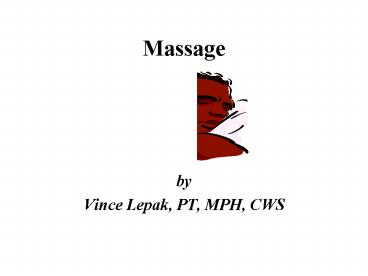Massage - PowerPoint PPT Presentation
1 / 25
Title: Massage
1
Massage
- by
- Vince Lepak, PT, MPH, CWS
2
Objectives
- Students will
- learn the physiological effects of massage.
- differentiate between reflexive and mechanical
effects of massage. - understand the effects on range of motion and
recovery of muscle function after exercise. - know the various strokes of massage.
- know treatment guidelines for the correct
implementation of massage. - This includes indications and contraindications.
3
General Overview
4
Reflexive Effects (slide 1 of 2)
- On Pain
- Gate control theory
- Endogenous Opiates release
- On Circulation
- Somatosympathetic reflex - probably does not
occur with massage, since massage is passive. - Axonal reflex occurs when cutaneous afferent
information travels antidromically and produces a
local vasodilation. (Reed, 1992)
5
Axonal reflex (Reed, 1992)
- localized erythema due to the decrease in
efferent input to the arterioles - no literature to support or refute this theory
6
Reflexive Effects (slide 2 of 2)
- On Metabolism
- Does not alter metabolism significantly. (Lehn
and Prentice, 1994) - On Motor Neuron Activity
- There is an inhibition of the spinal motor neuron
excitability during a massage. It is specific to
that muscle with no lingering effects. (Morelli,
Seaborne, Sullivan, 1991 Sullivan, Williams,
Seaborne, Morelli, 1991 Goldberg, Seaborne,
Sullivan, Leduc, 1994 and Goldberg, Seaborne,
Sullivan, 1992)
7
Mechanical Effects
- stretching and mobilizing tissues
- mechanically increase blood flow and venous
return of that muscle. (Lehn and Prentice,1994)
8
Circulation
- Light exercise is more effective in increasing
blood flow than massage. (Tiidus, 1997) - Cellular metabolism (Guyton Hall, 1996)
- Vasodilator Theory for Local Blood Flow
Regulation - Oxygen Demand Theory for Local Blood Flow Control
9
Effects on Range of Motion (ROM)
- Increase ROM short-term, but no Long-term
effects. (Crosman, Chateauvert, Weisberg, 1984)
10
Effects on the Recovery of Muscle Function
(Tiidus, 1997)
- Massage appears to have no benefit on recovery of
muscle function in the following situations - muscle damage caused by eccentric overload.
- recovery of post-exercise muscle strength.
- reduction of delayed onset muscle soreness
(DOMS). - rate of recovery of muscle function following
anaerobic work.
11
Psychological
- You communicate compassion, concern, anger,
sensual, or other emotions through touch.
12
Different types of strokes
- Effleurage (stroking)
- Superficial or Deep
- Petrissage (kneading)
- Friction
- Transverse or Longitudinal
- Vibration
- Tapotement
- Percussion/slapping/hacking/beating
13
Application (slide 1 of 3) (Hunter, 1994)
- Soft Tissue Healing
- Injury
- Protect
- Inflammatory Phase
- Effleurage (Lymphatic) massage
- Light petrissage
- Avoid friction massage
14
Application (slide 2 of 3) (Hunter, 1994)
- Fibroblastic-Repair Phase
- Effleurage and petrissage to reduce edema
- Friction to help tension the collagen for proper
alignment, thus preventing adhesions. - Maturation-Remodeling Phase
- Patient education
- Pain Cycle
15
Pain Cycle
(Weisberg, 1994, p.46)
16
Application (slide 3 of 3) (Hunter, 1994)
- Chronic Injury
- Friction
- Petrissage
- Effleurage (lymphatic)
17
Good Body Mechanics
18
(Fritz, 1995)
19
(Fritz, 1995)
20
Indications Contraindications
- Indications
- Patients with adhesions, edema, muscle spasm,
bursitis, tendinitis, tenosynovitis, strains, and
sprains. - Contraindications
- Patients with myositis ossificans, thrombosis or
embolism, severe varicose veins (caution), acute
phlebitis, cellulitis, synovitis, abscesses, shin
injections, and massage of a cancerous site.
21
Conclusion
22
Effectiveness of Massage
- 1 RCT (Preyde, 2000)
- sub-acute low back pain
- comprehensive massage (25), soft-tissue
manipulation only (25), remedial exercise with
education (22), placebo of sham laser (26) - Outcome measures Roland Disability Questionnaire
(Q), Sickness Impact Profile, McGill Pain Q
(Present Pain Index Pain Rating Index), State
Anxiety Index, Modified Schober test.
23
Results
- Roland Disability Q
- Massage Soft-tissue Manipulation showed
significant improvement in function - Overall,
- comprehensive massage was the only one to
maintain statistical significance over the sham
group on all the outcome measures.
24
References (slide 1 of 2)
- Crosman, L. J., Chateauvert, S. R., Weisberg,
J. (1984). The effects of massage to the
hamstring muscle group on range of motion.
Journal of Orthopeadic Sports Physical Therapy,
6 (3), 168-172. - Day, J. A., Mason, R. R., Chesrown, S. E.
(1987). Effect of massage on serum level of
ß-endorphin and ß-lipotopin in health adults.
Physical Therapy, 67, 926-930. - Fritz, S. (1995). Mosbys fundamentals of
therapeutic massage. St. Louis, MO Mosby. - Goldberg, J., Seaborne, D. E., Sullivan, S. J.,
Leduc, B. E. (1994). The effect of therapeutic
massage on H-reflex amplitude in persons with a
spinal cord injury. Physical Therapy, 74,
728-737. - Goldberg, J., Sullivan, S. J., Seaborne, D. E.
(1992). The effect on two intensities of massage
on H-reflex amplitude. Physical Therapy, 72,
449-457. - Guyton, A. C., Hall, J. E. (1996). Local
control of blood flow by the tissues, and humoral
regulation. In Textbook of medical physiology
(9th ed., pp. 199-208). Philadelphia, PA W. B.
Saunders.
25
References (slide 2 of 2)
- Hunter, G. (1994, January). Specific soft tissue
mobilisation in the treatment of soft tissue
lesions. Physiotherapy, 15-21. - Lehn, C. Prentice, W. E. (1994). Massage. In
W. E. Prentice (Ed.), Therapeutic modalities in
sports medicine (3rd ed., pp. 335-363). St.
Louis, MO Mosby. - Morelli, M., Seaborne, D. E., Sullivan, S. J. (
1991). H-reflex modulation during manual muscle
massage of human triceps surae. Archives of
Physical Medicine Rehabilitation, 72, 915-919. - Preyde, M. (2000). Effectiveness of massage
therapy for subacute low-back pain a randomized
controlled trail. Canadian Medical Association
Journal, 1815-1820. - Reed, B. V. (1992, Spring). Electrical
stimulation in circulatory disorders. Physical
Therapy Practice, 30-40. - Sullivan, S. J., Williams, L. R. T., Seaborne, D.
E., Morelli, M. (1991). Effects of massage on
alpha motoneuron excitability. Physical Therapy,
71, 555-560. - Tiidus, P. M. (1997). Manual massage and
recovery of muscle function following exercise a
literature review. Journal of Orthopaedic
Sports Physical Therapy, 25 (2), 107-112.































